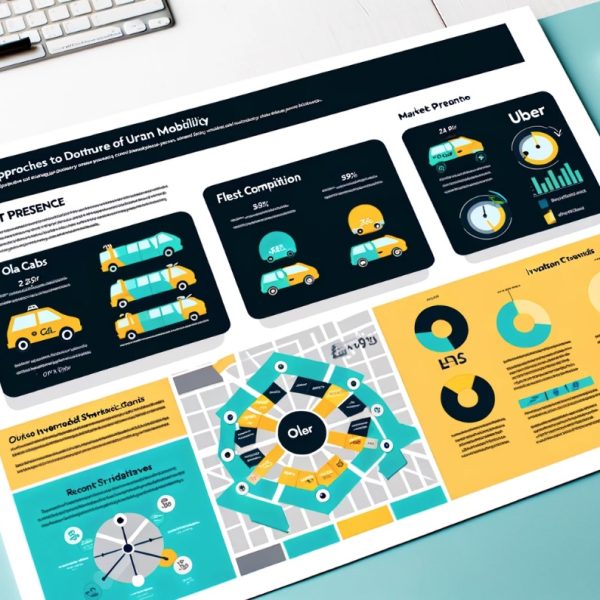Ola vs Blusmart vs Uber – Updated 2025
February 18, 2024
Industry: ride hailing
Subject: Startups

Ola, Uber, and BluSmart shaped India’s ride-hailing market in 2025. Uber leads with 50% share, Ola focuses on AI innovation and domestic growth, while BluSmart’s all-electric model collapsed due to governance failures. The sector’s future hinges on AI integration, EV adoption, sustainable pricing, and strong customer experience.
The Indian ride-hailing industry is undergoing one of its most transformative phases yet. Increased urbanisation, rising smartphone penetration, digital payment adoption, and the need for cost-effective mobility solutions have fuelled rapid growth in online taxi booking platforms.
Three names have shaped this market in recent years—Ola, Uber, and BluSmart. Each brought a unique business model, technology strategy, and market focus. However, recent events have reshaped the competitive landscape, making 2025 a defining year for the sector.
This updated comparison looks at market share, innovations, service models, operational challenges, and the future of ride-hailing in India.
1. Market Position and Competitive Dynamics
Ola Consumer
Ola remains one of the most recognisable brands in India’s urban mobility space, operating in more than 250 cities nationwide. In 2024, Ola made a bold move by exiting all international markets to focus entirely on India. This allowed the company to channel resources into its domestic ride-hailing, financial services, AI-driven innovations, and mapping capabilities. The brand has also been expanding its ecosystem to reduce reliance solely on rides, integrating mobility with payments and local commerce.
Uber India
Uber continues to be the market leader in India’s ride-hailing sector, holding around 50% market share. Its strong brand presence, wide service range (including Uber Auto and Uber Rentals), and operational scale give it a competitive edge. Uber has also adapted to India-specific market needs by introducing subscription-based driver pricing for auto-rickshaw services, replacing the traditional commission model, which helps improve driver retention.
BluSmart
BluSmart entered the market as India’s first all-electric cab service, targeting premium customers in metro hubs like Delhi NCR and Bengaluru. With a fleet of over 8,000 EV cabs at its peak, it positioned itself as a clean mobility disruptor, offering no-surge pricing and high service reliability. However, in April 2025, BluSmart suspended all operations following severe financial and governance issues.
2. Service Innovations and Technology
Ola has invested heavily in AI and automation. Its launch of Kruti, a multilingual AI assistant, marked a significant leap in customer interaction technology. Kruti can book rides, handle multi-step tasks, and integrate with other Ola services seamlessly. Ola is also building its own mapping and navigation system to reduce dependence on third-party providers.
Uber has focused on pricing innovation and local adaptability. Its zero-commission subscription model for auto-rickshaw drivers allows them to keep 100% of their fares after paying a flat daily or weekly fee. This makes Uber more attractive to drivers and helps secure supply in competitive cities.
BluSmart differentiated itself through a company-owned fleet model. Unlike Ola and Uber’s driver-owned vehicle approach, BluSmart maintained its own EV fleet, ensuring consistent maintenance, standardised driver training, and predictable service quality.
3. The Fall of BluSmart
BluSmart’s collapse was one of the most dramatic events in India’s mobility sector. The company faced a regulatory investigation into alleged financial mismanagement, including the misuse of funds intended for electric vehicle acquisitions. Key promoters were barred from holding directorship positions, leading to operational paralysis.
The sudden shutdown left thousands of drivers unemployed and customers without service, showing how rapid scale without robust governance can destabilise even innovative business models.
4. Market Outlook and Demand Trends
The ride-hailing market in India is forecast to grow at a compound annual growth rate (CAGR) of around 18–19% from 2024 to 2032, expanding from roughly USD 950 million in 2024 to over USD 3.7 billion by 2032.
Key growth drivers include:
-
Urbanisation and rising middle-class incomes
-
Increased penetration of smartphones and mobile internet
-
Widespread adoption of digital payment systems
-
Growing demand for electric cab services in line with sustainability goals
By 2025, online bookings are projected to account for over 56% of all taxi trips in India, with ride-hailing platforms capturing close to 60% of the market share.
5. Strategic Summary – Who Has the Edge?
| Company | Key Strengths | Key Challenges |
|---|---|---|
| Uber India | Largest market share, adaptive pricing models, strong brand presence, robust driver network | Increasing competition from localised models and government-backed mobility platforms |
| Ola Consumer | Domestic focus, AI-powered innovations, diversified revenue streams, strong city coverage | Needs to regain market share lost to Uber, improve driver satisfaction |
| BluSmart | First-mover advantage in all-electric taxis, high service quality | Complete operational shutdown, governance failures |
6. Conclusion – The Future of Ride-Hailing in India
In 2025, the best taxi app in India will largely depend on customer priorities:
-
For widespread availability and service variety, Uber leads.
-
For technology-driven innovation and ecosystem integration, Ola is closing the gap.
-
BluSmart, despite its innovative electric model, serves as a cautionary tale about balancing growth with operational integrity.
The coming years will see AI integration, EV adoption, pricing innovation, and regulatory compliance as the key factors shaping who dominates India’s ride-hailing market.








